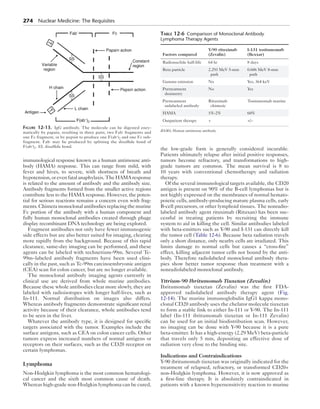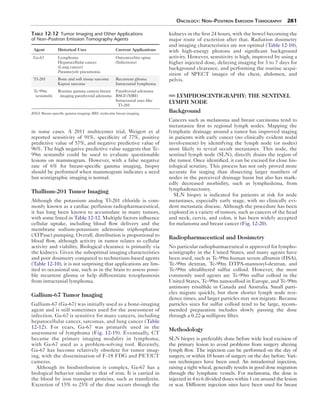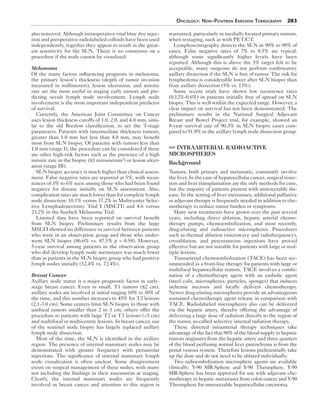This document discusses non-PET imaging techniques for oncology applications. It focuses on peptide receptor imaging using radiolabeled somatostatin analogs such as In-111 pentetreotide, which binds to somatostatin receptors overexpressed on many neuroendocrine tumors. In-111 pentetreotide scintigraphy has high sensitivity for detecting carcinoid tumors and other neuroendocrine tumors but lower sensitivity for insulinomas. It provides whole body imaging of tumor lesions and localization of disease when combined with SPECT or SPECT/CT. While F-18 FDG PET is useful for more aggressive tumors, In-111 pentetreotide remains an important functional imaging tool for somatostatin receptor-expressing neuro

![266 Nuclear Medicine: The Requisites
Several agents have been developed that readily bind to
somatostatin receptors (Fig. 12-2). Octreotide is an
8-amino-acid peptide that maintains the ability to bind to
native hormone receptors but is resistant to enzymatic
degradation with a 1.5- to 2-hour half-life, as opposed to
the 2- to 3-minute half-life of endogenous somatostatin.
Nonradiolabeled octreotide (Sandostatin) has been
approved by the U.S. Food and Drug Administration
(FDA) as a therapeutic agent, suppressing growth in acro-megaly
and controlling symptoms in carcinoid syndrome.
Indium-111 Pentetreotide
(Indium-111 OctreoScan)
Pharmacokinetics and Dosimetry
Radiolabeling indium-111 pentetreotide In-111-DTPA-pentetreotide
(In-111 pentetreotide [OctreoScan; Mallinck-rodt,
Hazelwood, MO]) involves complexing octreotide
with diethylenetriaminepentaacetic acid (DTPA) to bind
In-111. In-111 pentetreotide is rapidly cleared by the kid-neys,
with 50% of the dose excreted by 6 hours and 85% by
Table 12-1 Multiple Endocrine Neoplasia (MEN) Syndromes
Lesion MEN-I MEN-IIA MEN-IIB
Pituitary adenoma +
Pancreatic islet cell tumor +
Parathyroid adenoma + +
Pheochromocytoma + +
Medullary thyroid cancer + +
Ganglioneuroma +
Figure 12-1. Somatostatin receptors are found on many tumors, includ-ing
those derived from neuroendocrine cells. GH, Growth hormone; TSH,
thyroid-stimulating; VIPoma, vasoactive intestinal polypeptide-secreting
tumors; Z-E, Zollinger Ellison.
Ala-Gly-Cys-Lys-Asn-Phe-
Phe
D-Trp
Lys
s
s
D-Phe-Cys-
s
s
Thr-OL-Cys-
Phe
Cys-Ser-Thr-Phe-
Thr
Somatostatin Octreotide
D-Phe-Cys-
123I
s
s
Thr-OL-Cys-
Phe
D-Trp
Lys
Thr
D-Trp
Lys
Thr
111In-DTPA-D-Phe-Cys-
s
s
Thr-OL-Cys-
Phe
D-Trp
Lys
Thr
I-123 octreotide In-111 pentetreotide
Figure 12-2. Comparison of somatostatin analogs octreotide, I-123
pentetreotide, and In-111 pentetreotide.
A Ant
Octreoscan 4 hr
Post B Ant
Octreoscan 24 hr
Post
Figure 12-3. Normal In-111 pen-tetreotide
whole-body scans at (A)
4 hours and at (B) 24 hours. Note
increasing bowel activity over time.
Significant renal uptake is classic
but may be less intense in some
patients. Activity in the spleen is
more intense than in the liver in
this case, although this varies. Ant,
Anterior; Post, posterior.](https://image.slidesharecdn.com/12oncolnonpet-141117030326-conversion-gate01/85/12-oncol-non-pet-2-320.jpg)



![270 Nuclear Medicine: The Requisites
before injection to prevent uptake of free radioiodine by
the thyroid and continuing for 3 to 6 days to prevent free
radioiodine uptake in thyroid (Table 12-5). Although I-123
can be imaged with a low-energy collimator, a small frac-tion
of the photons (<3%) may be high energy (440-625
keV [2.4%] and 625-784 keV [0.15%]), reducing image
quality. Therefore a medium-energy collimator may be
preferable. Images are acquired 24 hours after injection.
For pheochromocytoma, posterior and anterior views of
the abdomen are most important. Additional images from
the pelvis to the base of the skull are indicated to detect
extraadrenal pheochromocytoma and neuroblastomas.
Whole-body imaging is indicated for patients with neuro-blastoma.
SPECT and or SPECT/CT are routine at many
centers, improving sensitivity and accuracy.
Clinical Applications
Pheochromocytoma
Pheochromocytoma is an uncommon catecholamine-secret-ing
tumor derived from chromaffin cells. When these tumors
arise outside of the adrenal gland, they are termed extraadre-nal
pheochromocytomas, or paragangliomas. Because of
excessive catecholamine secretion, they can precipitate life-threatening
hypertension or cardiac arrhythmias. Ten percent
of pheochromocytomas are bilateral, 10% are extraadrenal
(paragangliomas), and 10% are malignant. Paragangliomas
may be found from the bladder up to the base of the skull.
Box 12-4. Iodine-123 and Iodine-131 MIBG:
Summary Protocol
PATIENT PREPARATION
Hydration
Thyroid blockade (Table 12-5) with Lugol solution or
potassium iodide. Begin day before injection and
continue 1 to 2 days for I-123 and 3 to 6 days for
I-131 MIBG
Discontinue interfering medications (Table 12-4)
RADIOPHARMACEUTICAL
IV dose injections must be done slowly, over at least
5 minutes
I-123 MIBG
Children: 0.14 mCi/kg (5.2 MBq/kg); minimum 1.0 mCi
(20 MBq) and maximum 10.8 mCi (400 MBq)*
Adults: 10.8 mCi (400 MBq)
I-131 MIBG: Adults 1.2-2.2 mCi (40-80 MBq)
INSTRUMENTATION
Gamma camera: Large field of view for planar images
Modern SPECT/CT hybrid systems recommended
for SPECT
Collimator:
I-123: Medium energy, parallel hole
I-131: High energy, parallel hole
ACQUISITION
I-123: Image at 20 to 24 hours. Delayed images less
than 2 days for equivocal cases.
I-131: Image 1 to 2 days after injection. Repeat
images at day 3 if needed.
Spot views: 75,000 to 100,000 counts for I-123
preferred, 256 × 256 matrix or 128 × 128 with zoom.
Whole body planar images (5 cm/sec) and limited
spot views (500,000 counts or 10 minutes) can be
done in adults.
SPECT: 3-degree steps, 25 to 35 sec/step, 120
projections, 128 × 128 matrix.
Uncooperative patients: consider 6-degree steps, or
64 × 64 matrix with shorter time per frame.
*Data from Gelfand MJ, Parisi MT, Treves ST. North American consensus guide-lines
for administered radiopharmaceutical activities in children and adolescents.
J Nucl Med. 2011;52(2):318-322.
MIBG, Meta-iodo-benzyl-guanidine.
Table 12-5 Daily Doses of Thyroid Blockade Compounds
Drug Adults
Child
(15-50 kg)
Child
(5-15 kg)
Child
(<5 kg)
CAPSULES*
Potassium iodate 170 80 40 20
Potassium iodide 130 65 32 16
Potassium
400 300 200 100
perchlorate
SOLUTION
Lugol solution 1% 1 drop/kg to max 40 (20 drops twice daily)
*Dose in milligram per day. Data from Giammarile F, Chiti A, Lassmann M, et al.
EANM procedure guidelines for I-131 MIBG therapy. Eur J Nucl Med Mol Imaging.
2008;35(5):1039-1047.
Table 12-4 Medications Discontinue Before MIBG Imaging
Drug Related drugs Mechanism No. days to stop
Antihypertensive/cardiac
agents
Bretylium, guanethidine, reserpine
Calcium channel blockers (amlodipine, nifedipine, nicardipine)
Labetalol
Deplete granules
Deplete granules
Deplete granlues and
inhibit uptake
7-14
Antipsychotics Butyrophenones (droperidol, haloperidol)
Loxapine
Phenothiazines (chlorpromazine, fluphenazine, promethazine, others)
Inhibit uptake
Inhibit uptake
Inhibit uptake
21-28
7-21
21-28
Cocaine/opioids Inhibit uptake 7-14
Sympathicomimetics Amphetamine, dopamine, ephedrine, isoproterenol, phenoterol,
phenylephrine, phenylpropanolamine, pseudoephedrine,
salbutamol, terbutaline, xylometazoline
Deplete granules 7-14
Tramadol Inhibit uptake 7-14
Tricyclic antidepressants Amitriptyline (and derivatives), amoxapine, doxepine, others Inhibit uptake 7-21
MIBG, Meta-iodobenzylguanidine.](https://image.slidesharecdn.com/12oncolnonpet-141117030326-conversion-gate01/85/12-oncol-non-pet-6-320.jpg)









![280 Nuclear Medicine: The Requisites
systems, such as cadmium zinc telluride (CZT), show even
higher intrinsic spatial resolution and the potential for even
greater sensitivity at lower administered doses. In addition,
newer dual-head detector cameras may better image tumors
at low doses, helping minimize the impact of distance from
the detector.
Uptake and Dosimetry
The methoxy-isobutyl-isonitrile lipophilic cation passively
diffuses into the cell, and retention results from attraction
between the positively charged lipophilic molecule
and the negatively charged mitochondria. Up to 90% of
Tc-99m sestamibi is concentrated in the mitochondria.
Clearance from the cells is slow, allowing more than ade-quate
time for imaging. P-glycoprotein, increased in cases
expressing a multidrug resistance gene, pumps cations and
lipophilic substances out of cells and may have an impact
on the use of Tc-99m sestamibi in following therapy
response.
The breast is highly radiation sensitive, and the risk for
radiation-induced cancers from imaging studies such as mam-mography
have been calculated. Efforts to bring the effective
dose down to at least the level of a mammogram (2-4 mCi
[75-150 MBq]) are highly desirable. However, in some
patient populations, the risk-to-benefit ratios suggest that
even the higher doses of Tc-99m sestamibi may be worth-while
if scans can identify cancers that cannot otherwise be
found, such as in high-risk patients with dense breasts.
Methodology
A sample protocol is listed in Box 12-5. However, the dose
of Tc-99m sestamibi recommended was based on recom-mendations
from standard cameras with a large field of
view. Significantly lower doses are being investigated for
molecular breast imaging in which dedicated breast cam-eras
put the breast in close approximation with the detec-tors.
Many sites use 8 mCi (296 MBq), and early studies
report success with much lower doses—as low as 2 to 4
mCi (74-148 MBq).
To help prevent false positive examination results, imag-ing
should be done after a delay of 3 to 4 weeks after core
biopsy or 2 weeks after fine-needle aspiration. Imaging early
in the menstrual cycle (days 2-12) is also recommended.
Interpretation
Normal breast parenchyma shows mild, usually symmet-ric
activity. Small focal areas of uptake are most suggestive
of malignancy, and patchy uptake is likely benign.
Box 12-5. Technetium-99m Sestamibi
Scintimammography and Breast-Specific Gamma
Imaging: Summary Protocol
PATIENT PREPARATION
None
RADIOPHARMACEUTICAL
8 mCi (296 MBq) Tc-99m sestamibi intravenously
*Consider lower doses (2-4 mCi [74-148 MBq]) for
dual head cadmium zinc telluride detector small
field of view dedicated breast cameras.
INSTRUMENTATION AND ACQUISITION
Small field of view dedicated single-head or dual-head
breast camera
Begin imaging 5 to 10 minutes after injection
Immobilize breast with light compression
Image 7 to 10 min/view (craniocaudad [CC] and
mediolateral oblique [MLO])
Image injection site
Additional views optional: True (90-degrees)
lateral, axillary tail, cleavage view, exaggerated
CC, implant displacement
Routine gamma camera (not preferred)
Begin imaging 5 to 10 minutes after injection
Place patient prone on table with breasts hanging
dependent, preferably in holder through cutouts
10 minutes/view for prone lateral and supine
anteroposterior chest, including axilla
Image injection site
Obtain marker view of any palpable nodule
However, the intensity of the uptake may not parallel the
aggressiveness of the lesion. Uptake in the axilla may rep-resent
nodal metastasis, particularly if no dose infiltration
is seen.
The sensitivity of breast-specific gamma imaging is high,
on the order of 91% to 95%. Lesions larger than 1 cm are
generally easily seen. For subcentimeter lesions, sensitiv-ity
varies, with reports of 3 to 7 mm routinely visualized,
although sensitivity decreases with size. Limited data have
shown superior detection of tumors over mammography in
patients with dense breasts and higher sensitivity for lobu-lar
carcinomas than other breast imaging modalities,
including MRI. In addition, early studies show specificity
at least similar to that of MRI, although higher (65%-90%)
Table 12-11 Comparison of Radiation Doses in Breast Imaging*
Modality Breast dose mGy/mCi (mGy/MBq) Effective dose mSv/mCi (mSv/MBq)
Tc-99m sestamibi 0.141 (0.0038) 25 mCi = 3.5 mGy 0.333 (0.009) 25 mCi = 8.3 mSv
8 mCi = 2.66 mSv
4 mCi = 1.33 mSv
2 mCi = 0.67 mSv
F-18 FDG PET 0.318 (0.0086) 10 mCi = 3.2 mGy 0.703 (0.019) 10 mCi = 7.03 mSv
Digital mammography 1-1.2 mGy/view (4-5 mGy/4 views) 0.48-0.6 mSv/4 views
*Based on International Commission on Radiological Protection weighting.
FDG, Fluorodeoxyglucose; PET, positron emission tomography.](https://image.slidesharecdn.com/12oncolnonpet-141117030326-conversion-gate01/85/12-oncol-non-pet-16-320.jpg)




![Oncology: Non–Positron Emission Tomography 285
and development of necrosis within the lesion. F-18 FDG
PET/CT has been done at 1 month and may help monitor
response (Fig. 12-23). The majority of patients demon-strate
at least partial response. Studies have shown
responses in patients who were not responding to chemo-therapy,
with hepatocellular cancer in some patients
becoming resectable. Limited data suggest some improve-ment
in median survival, particularly in those receiving
higher doses.
BONE PAIN PALLIATION
Metastatic disease to the bone is a common problem causing
significant pain and disability in patients with cancer.
Numerous methods are available for the treatment of bone
pain. These include analgesics, chemotherapy drugs, hor-monal
therapy, bisphosphonates, external beam radiation,
and even surgery. Radiopharmaceuticals are an important
addition to this list of treatments. Radiopharmaceuticals
available for treatment of bone pain are listed in Table 12-16.
Bone-seeking radiopharmaceuticals have been used to
treat bone pain from cancer for decades. These agents local-ize
to bone, in areas of bone repair and turnover. Therefore
they deposit in areas of metastasis. The therapeutic effects
depend on the emission of beta particles. Beta particles are
high energy but travel only millimeters from the site of
deposition. This ensures the effects are limited to the
abnormal bone and normal tissue is spared. These agents
are extremely useful because they can be given in addition
to other therapies such as external beam radiation or even
after external beam therapy has reached maximal limits.
Phosphorus-32
Phosphorus-32 is one of the earliest known bone-seeking
radioisotopes. It has been used in intraperitoneal infusion
for treatment of tumors such as ovarian cancer and in the
treatment of polycythemia vera. It is available for intrave-nous
administration for bone pain palliation. A range of
skeletal absorbed doses have been calculated (25-63 rad/
mCi [0.68-1.733 cGy/MBq]). However, it appears that the
normal marrow receives a high dose relative to the tumor as
a result of distribution of P-32 in the inorganic matrix and
Figure 12-22. Planar Y-90 microspheres image after intrahepatic artery
injection for therapy using the bremsstrahlung radiation. Although planar
images can determine whether the distribution is adequate, SPECT
fused with CT provides better correlation.
A B
Figure 12-23. Monitoring therapy. F-18 FDG PET/CT images of the liver in a patient with unresectable hepatocellular carcinoma (A) before and
(B) 1 month after Y-90 Therasphere administration show marked improvement.
Table 12-16 Radiopharmaceuticals for Bone Pain Palliation
Radionuclide Pharmaceutical
Physical half-life
(days)
β Max
(MeV) Beta mean (MeV)
Maximal tissue
distance (mm)
Gamma photon
(keV)
P-32 Orthophosphate 14.3 1.71 0.695 8 —
Sr-89 Chloride 50.5 1.46 0.583 6.7 —
Sm-153 EDTMP 1.95 0.8 0.224 3.4 103
Re-186 HEDP 3.8 1.07 0.349 4.7 137
EDTMP, Ethylenediamine tetra; HEDP, hydroxyethylidene-1, 1-diphosphonic acid.](https://image.slidesharecdn.com/12oncolnonpet-141117030326-conversion-gate01/85/12-oncol-non-pet-21-320.jpg)

![Oncology: Non–Positron Emission Tomography 287
As in Sr-89, the bone marrow toxicity is a limiting fac-tor.
Toxicity is usually mild, although serious side effects
and even fatalities have been reported. Platelets
decreased on the order of 25% from baseline and white
blood cells by 20%.
The short range of the Sm-153 beta particle should be
advantageous when considering the dose to normal mar-row.
A response rate on the order of 83% has been reported.
Pain relief is generally noted within 2 weeks, with a dura-tion
of 4 to 40 weeks.
Rhenium-186 Hydroxyethylidene
Diphosphonate
Rhenium-186 hydroxyethylidene diphosphonate (HEDP)
is formed by combining a diphosphonate useful for bone
pain therapy, etidronate, with a beta-emitter. Re-186
HEDP is another agent that may be useful for the pallia-tion
of bone pain. It emits a gamma ray useful for imaging
and lesion identification. It rapidly localizes to bone, with
approximately 14% retained in bone. The remainder is
rapidly cleared, with approximately 70% of the dose
excreted in the urine 6 hours after injection.
Suggested Reading
Breast
Berg WA, Zheng Z, Lehrer D, et al. Detection of breast cancer with the addition
of annual screening ultrasound or single-screening MRI to mammography in
women with elevated breast cancer risk. JAMA. 2012;307:1775-1877.
Berg WA, Madsen KS, Schilling K, et al. Comparative effectiveness of positron
emission mammography and MRI in the contralateral breast of women with
newly diagnosed breast cancer. AJR Am J Roentgenol. 2012;198:219-232.
Conners AL, Hruska CB, Tortorelli CL, et al. Lexicon for standardized
interpretation of gamma camera molecular breast imaging: observer agreement
and diagnostic accuracy. Eur J Nucl Med Mol Imaging. 2012:Jan 31 [Epub ahead
of print.]
Goldsmith SJ, Parsons W, Guiberteau MJ, et al. SNM practice guideline for breast
scintigraphy with breast-specific γ-cameras. 2010. Available at: http://snm.org/
guidelines.
Hendrick RE. Radiation doses and cancer risks from breast imaging studies.
Radiology. 2010;257(1):246-253.
O’Connor MK, Hua L, Rhodes DJ, et al. Comparison of radiation exposure and
associated radiation-induced cancer risks from mammography and molecular
imaging of the breast. Med Phys. 2010;37(12):6187-6198.
Rhodes DJ, Hruska CB, Phillips SW, Whaley DH, O’Connor MK. Dedicated
dual-head gamma imaging for breast cancer in women with dense breasts.
Radiology. 2011;258(1):106-118.
Tadwalkar RV, Rapelyea JA, Torrente J, et al. Breast-specific gamma imaging as an
adjunct modality for the diagnosis of invasive breast cancer with correlation to
tumor size and grade. Br J Radiol. 2011;85(1014):e212-e216.
Wahner-Roedler DL, Boughey JC, Hruska CB, et al. The use of molecular breast
imaging to assess response in women undergoing neoadjuvant therapy for breast
cancer: a pilot study. Clin Nucl Med. 2012;37(4):344-350.
Wang CL, MacDonald LR, Rogers JV. Positron emission mammography:
correlation of estrogen receptor, progesterone receptor, and human epidermal
growth factor receptor 2 status and 18F-FDG. AJR Am J Roentgenol.
2011;197(2):W247-W255.
Weigert JM, Bertrand ML, Lankowsky L, Stern LH, Kieper DA. Results of a
multicenter registry to determine the clinical impact of breast-specific gamma
imaging, a molecular breast imaging technique. AJR Am J Roentgenol.
2011;198(1):W69-W75.
Somatostatin Receptor Imaging
Balon HR, Goldsmith SJ, Siegel BA, et al. Society of nuclear medicine
procedure guideline for somatostatin receptor scintigraphy with In-111
pentetreotide, version 2.0. 2002. Available at: http://interactive.snm.org/docs/
SRS_Final_v2_0.pdf.
Kabasakal L, Demirci E, Ocak M. Comparison of (68)Ga-DOTATAE and (68)
Ga-DOTANOC PET/CT imaging in the same patient group with neuroendo-crine
tumors. Eur J Nucl Med Mol Imaging. 2012;39(8):1271-1277.
Kwekkeboom DJ, Krenning EP. Somatostatin receptor imaging. Semin Nucl Med.
2002;32(2):84-91.
Adrenal Imaging
Bombardieri E, Giammarile F, Aktolum C, et al. 131I/123I-Metaiodobenzylguanidine
(MIBG) scintigraphy-procedure guidelines for tumor imaging. 2010. Available
at: http://interactive.snm.org/docs/EANM_guideline_for_I131_I123_MIBG_
Scintigraphy.pdf.
Antibody Imaging
Hagenbeek A. Radioimmunotherapy for NHL: experience of 90Y-ibritumomab
tiuxetan in clinical practice. Leuk Lymphoma. 2003;44(suppl 4):S37-S47.
Rieter WJ, Keane TE, Ahlman MA, et al. Diagnostic performance of In-111
capromab pendetide SPECT-CT in localized and metastatic prostate cancer.
Clin Nucl Med. 2011;36:872-878.
Taneja SS. ProstaScint® scan: contemporary use in clinical practice. Rev Urol.
2004;6(suppl 10):S19-S28.
Wong TZ, Turkinton TG, Polascik TJ, Coleman RE. ProstaScint (capromab
pendetide) imaging using hybrid gamma camera-CT technology. AJR Am J
Roentgenol. 2005;184(2):676-680.
Wyngaert JK, Noz ME, Ellerin B, et al. Procedure for unmasking localization
information from ProstaScint scans for prostate radiation therapy treatment
planning. Int J Radiat Oncol Biol Phys. 2004;60(2):654-662.
Lymphoscintigraphy
Buscombe J, Paganelli G, Burak ZE, et al. Sentinel node in breast cancer
procedural guidelines. Eur J Nucl Med Mol Imaging. 2007;34(12):2154-2159.
Gershenwald JE, Ross MI. Sentinel-lymph-node biopsy for cutaneous melanoma.
N Engl J Med. 2011;364(18):1738-1745.
Hindie E, Groheux D, Brenot-Rossi I. The sentinel node procedure in breast
cancer: nuclear medicine as a starting point. J Nucl Med. 2011;52(3):405-414.
Lyman GH, Giuliano AE, Somerfield MR, et al. American society of clinical
oncology guideline recommendations for sentinel lymph node biopsy in early
stage breast cancer. J Clin Oncol. 2005;23(30):7703-7720.
Intraarterial Microsphere Therapy
Ahmadzadehfar H, Biersack HJ, Ezzidin S. Radioembolization of liver tumors with
yttrium-90 microspheres. Semin Nucl Med. 2010;40(2):105-121.
Kalva SP, Thabet A, Wicky S. Recent advances in transarterial therapy of primary
and secondary liver malignancies. Radiographics. 2008;28(1):101-117.](https://image.slidesharecdn.com/12oncolnonpet-141117030326-conversion-gate01/85/12-oncol-non-pet-23-320.jpg)